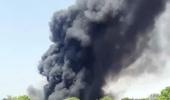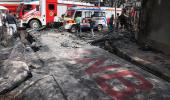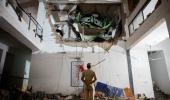'Data retrieval is just one part. Investigators also examine physical wreckage, pilot logs, and maintenance records.'

After a crash, the black boxes are often the first objects search and investigation teams try to retrieve. These recorders, usually located in the rear fuselage, are engineered to survive fire, water, and massive impact forces. But once they are found, the process of decoding their secrets begins.
Group Captain Rajiv Kumar Narang (retd) explains to Prasanna D Zore/Rediff the physical durability of black boxes, how much data they can store, and where they are typically located.
- Part 1: What CVR, FDR May Reveal
Where are CVRs and FDRs located on commercial aircraft, and why?
Placement varies by aircraft type, but they are typically located in parts of the fuselage where they are most likely to survive a crash -- often the tail section. They are built to be fireproof and shockproof to protect the data.
Are these recorders built to survive crashes? What makes them so durable?
Absolutely. Their casings are made from extremely tough materials that can withstand high temperatures and impact forces. This ruggedness is the result of decades of engineering and testing under extreme conditions.
How much data can modern recorders store?
Earlier systems stored up to three or seven days of data. Modern recorders can log a month or more, depending on design. This is especially useful for analysing complex incidents involving multiple flights or recurring technical issues.
After an accident, how do investigators retrieve and interpret the data?
Data retrieval is just one part. Investigators also examine physical wreckage, pilot logs, and maintenance records. Experts decode the audio and data using specialised tools and cross-reference it with physical evidence to establish a timeline and root cause.
NEXT: Pilot Error Or System Failure? What Black Box Data Reveals










